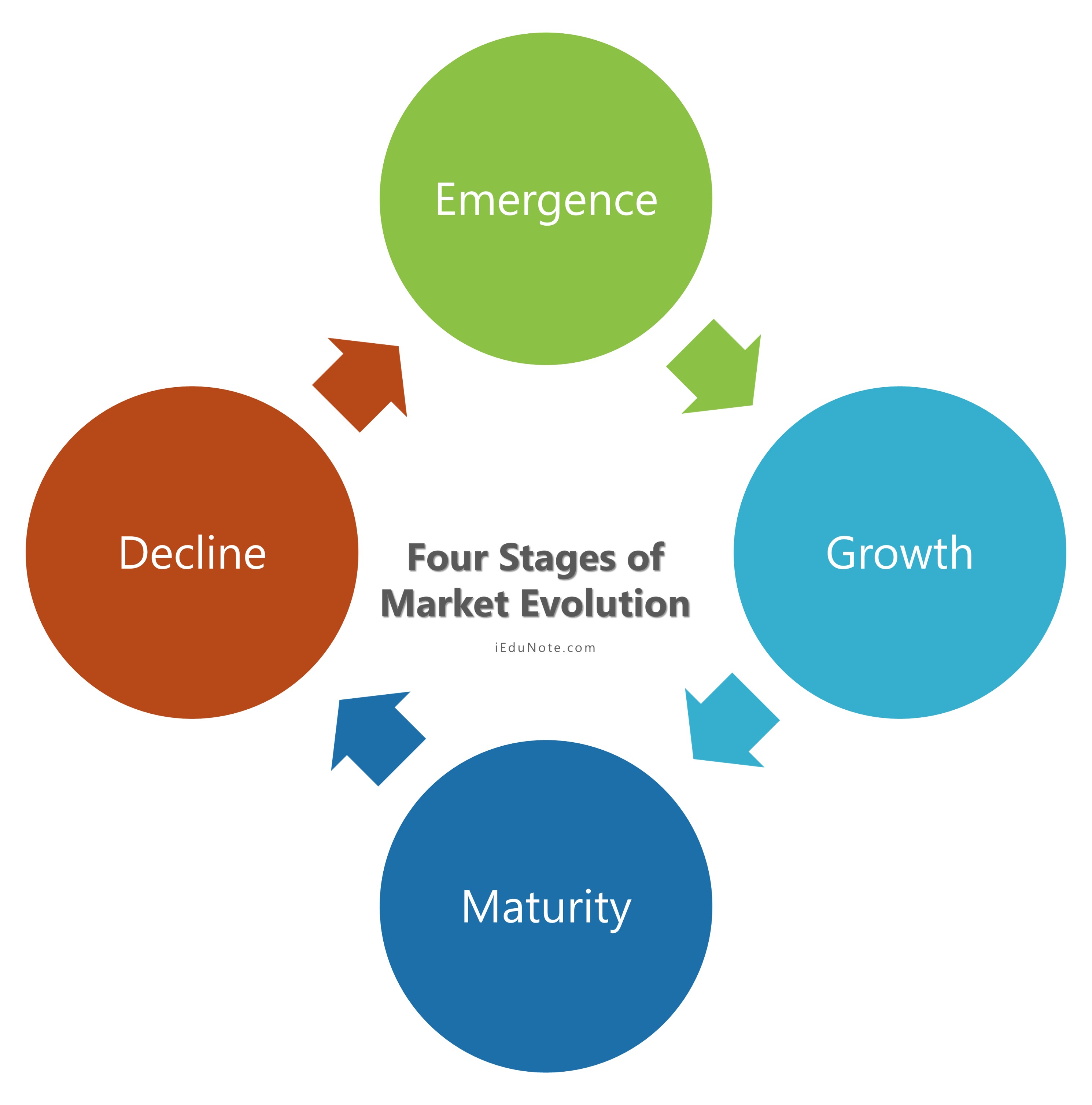Evolution, in dictionary term, means the process of growth. In other words, evolution is the theory that sees in the history of all things – a development or gradual advance from a simple and rudimentary condition to one that is more complex and of higher character.
Thus, market evolution means the development or gradual advance of the market from an initial position to one that is more critical. In the product life cycle concept; the attention there was on the product. This gives you a product-oriented scenario.
You should know, as well, what happens in different stages of the market during its evolution. We discussed the demand/technology life-cycle, which gives you some idea about the market in general. The contemporary world is dynamic in all aspects.
Changes take place in people’s needs, in competitive positions, in technology, in marketing mix elements, and virtually everywhere. As a present or potential marketing executive, you should be able to anticipate the evolution of the market in terms of everything that affects the market.
Stages of Market Evolution

Four stages of Market Evolution are;
- introduction/emergence,
- the growth,
- maturity, and
- decline.
Markets evolve through similar stages. Let us now have a look at them in turn :
1. Emergence Stage of Market
If any marketer does not serve a particular market, it remains in a latent form. We have so many needs, some of which are unmet because of the lack of products capable of satisfying a particular need.
This necessarily does not mean that market for a particular product capable of satisfying an unmet need is nonexistent. The market for such products is termed as latent. “A latent market consists of people who share a similar need or want for something that does not yet exist.”
You know that people have wanted for ages, a means for quicker travel. This need was satisfied by different means at different times.
But, people are yet not satisfied with the speed of the existing means of transportation. They want faster means. For example, an entrepreneur realizes this and is willing to develop something based on most modern computer technology capable of satisfying this need better than ever.
If he is serious, he should determine the new product’s attributes – superior and faster means of transport. If he claims himself to be market-oriented, he knows the potential buyers’ preferred levels on the attributes he has determined on which developments will be made.
After getting an idea of potential customers’ preference levels, the entrepreneur should design an optimal product to satisfy them.
But, you should remember that customers vary greatly in their preferences, and hence the entrepreneur may have to produce many different types of products to satisfy the majority.
If you look at the following figure, you will know how customers’ preferences vary.

In the above figure, each of the zeroes represents individual preference, which clearly tells us that preferences vary greatly. Some potential customers will be happy getting two new attributes, where others want as many as seven.
We can call such a market a diffused- preference market where buyers’ preferences scatter evenly. In such a situation, it is difficult to develop an optimal product catering to potential buyers’ needs.
Here, a marketer may pursue any one of the following three strategies:
- Single-Niche Strategy: If the marketer decides to develop the product to satisfy one of the corners of the market, it is termed as a single-niche strategy. Here he is foregoing the other corners, thus narrowing the size of potential sales.
- Multiple-Niche Strategy: If the marketer decides to develop and launch more than one new product aiming at more than one corner or segment of the total market, we call it a multiple-niche strategy. It involves the firm’s investment in terms of developing the product and providing for marketing facilities.
- Mass-Market Strategy: Under this strategy, the marketer aims at the middle portion of the market where concentration is heavy. If a firm decides to follow this strategy its potential sales could be expected to be much higher than the potential sales generated by the other two strategies.
The decision with regards to the strategy to be pursued depends to a great extent on the size of the firm. If a firm is small in size, it is likely to have limited resources – both financial and non-financial – limiting its entry to a mass market.
Under such a situation, it is wiser to target a particular corner of the market, i.e., to follow the single-niche strategy.
This will help the firm do business for a relatively long period in the niche without facing much competition. On the contrary, a bigger firm goes for a larger market; i.e., it follows the mass-market strategy.
Since a bigger firm is expected to have strengths in both financial and non-financial sides, it is relatively easy for the firm to capture the mass market. The emergence stage thus begins as one of the firms launches the product.
2. Growth Stage of Market
You know that the emergence stage starts with the launching of the product. On the other hand, the growth stage begins as new firms enter the market and compete with the pioneer firm.
Since this is the era of extreme competition, new firms will immediately enter the market if they see the market is profitable to operate.
The question that comes to our mind is that, where the new firms enter the market?
It is assumed that the pioneer firm has placed itself in the center.
Given the scenario, the new entrant in the market can choose one of the three alternatives. They are as follows:
- The new firm can decide to pursue the single-niche strategy, thus focusing on one corner of the total market.
- The second alternative is to pursue a mass-market strategy. Here the new entrant plans to place or position its product close to the pioneering firm.
- The third option is to go for the multiple-niche strategy. Here the firm first finds out few untapped corners of the market and then decides to capture a few corners.
As we have mentioned before, the decision on strategy depends on the strengths of the new firm. If it finds itself stronger and larger, it may decide to go for face-to-face/direct competition with the pioneering firm.
It may be successful or not depending on how it undertakes and implements the marketing programs. The new large firm may also decide to avoid direct competition and go for a multiple-niche strategy, giving it a competitive advantage.
The small new entrant, on the other hand, will always avoid the large pioneer firm. The small second firm should pursue a single-niche strategy to make easy access to the market.
3. Maturity Stage of Market
When most of the corners/parts/segments of a product’s total market are tapped and served by different competing firms, the market reaches the maturity stage.
It is a common picture of any market. In the initial stage, one or two firms dominate the market. Gradually new firms are attracted either because the market is profitable, or some of the segments remain unexplored.
When all of the major segments are covered, marketers find it unprofitable operating in one or a few segments. They then decide to attack each other’s segments and capture the segment’s total or part (s). This leads to lower profits for the competing firms.
This slows down the market growth, and customers start demanding more, leading to a more fragmented market. This again reduces competition within the segments. But as the segments’ sizes become smaller, profits further reduce, leading to market consolidation.
The innovative and larger firms will try to develop new attributes and influence customers more with new attributes. This will cause some customers to switch to the firm’s product, thus solidifying its position in the market.
As a result, some of the competitors will either be wiped out or pushed to certain corners of the market. This is called the market consolidation stage. The consolidated market also does not last long because other firms may imitate the firm’s new attribute, resulting in further competition.
The market again may be turned into a fragmented one. This fragmentation process to consolidation to fragmentation and again to consolidation continues for some time until the market reaches the decline stage.
4. Decline Stage of Market
You know that the process of fragmentation consolidation fragmentation continues for some time. At some point in time, the demand of the market will start reducing.
When this starts happening, the decline stage begins. There are two common reasons for the decline in market demand for a product.
First, society’s need level for a particular product may decline, which reduces the need for a specific product.
Second, new technology may emerge capable of producing better products.
If people are offered newer and better products, they will most likely substitute the old one for the new one. To survive, a firm should adapt itself to the new technology and new demands of society.

